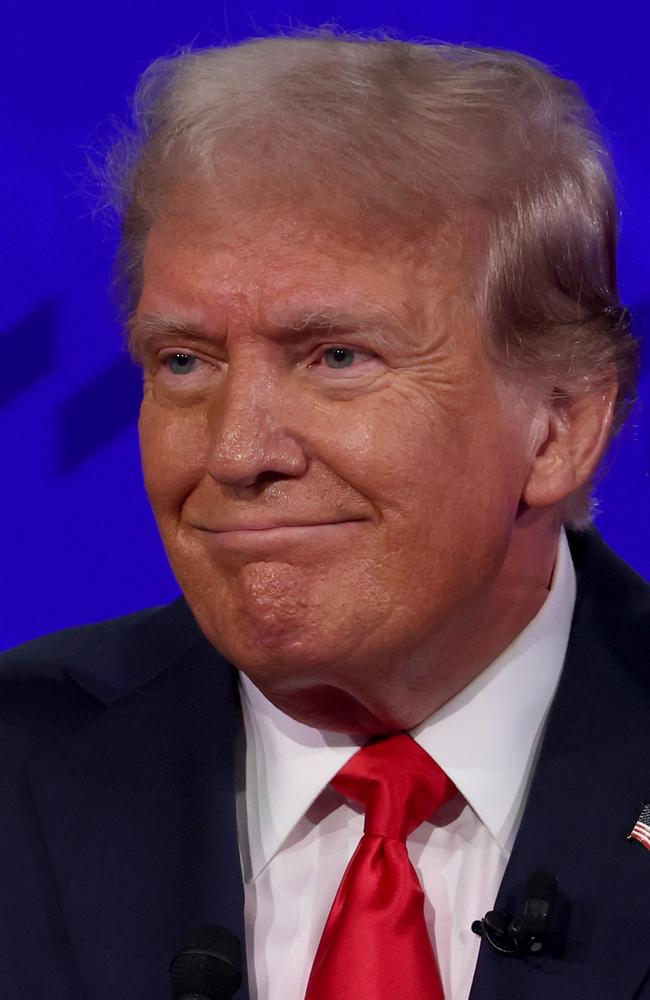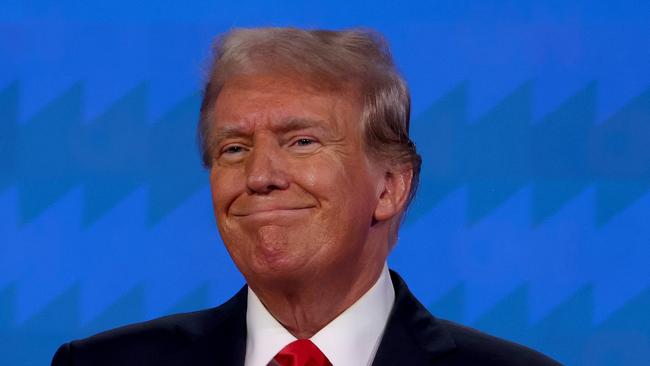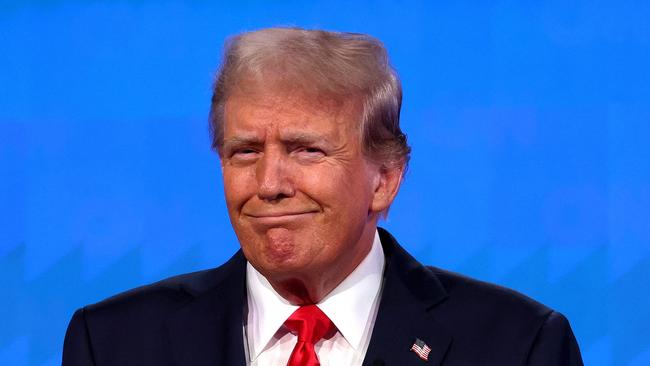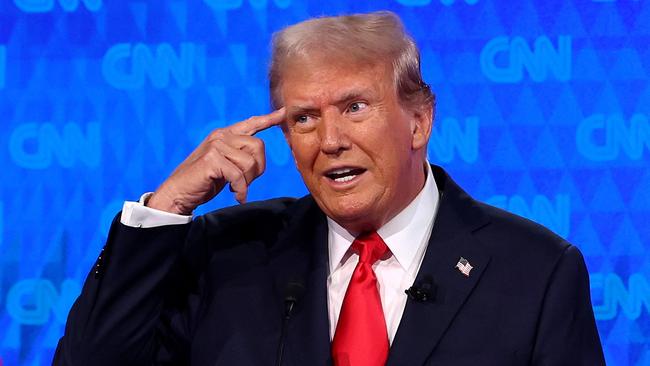Trump v Biden debate: Body language expert reveals signs missed
This wasn’t a competition; it was a wipe-out. But there was something Donald Trump did that left Biden appearing frail, confused and dazed, writes body language expert Katia Loisel.
Opinion
Don't miss out on the headlines from Opinion. Followed categories will be added to My News.
This was a career-ending debate for Biden.
This wasn’t a competition; it was a wipe-out. From the onset, Biden appeared frail, confused and dazed like a deer in the headlights, his normally open direct posture and eye contact replaced with a vulnerability we had not seen.
In contrast, Trump who is a big man, appeared visibly taller during Biden’s opening statement, pulling his shoulders back, lifting his chin and bouncing on his toes as if to say, ‘I’ve got this’.
Despite a shaky start marked by “a lack of illustrators and gestures, and general tension – his body stiff and upright”, Trump regained his composure.

“His open palm gesturing, his heart window open, conveying sincerity and honesty essentially saying, “You can trust me, I’m here to serve.”
His gestures became bigger his stance more relaxed as he leaned into the lectern in order to connect with the audience.

Trump’s contempt for Biden was “palatable” – using several tactics to mock and undermine him by “adopting a contempt or classic dominance, an asymmetrical smile in which one side of the lip raises in a smile with the other down turned or staying put and is a non-verbal threat signalling contempt and dominance.
There’s an old adage that says, “He who holds the best poker face wins.”
When the stakes and emotions are running high, it’s often not those with the best policy but those who can regulate their physiology and nonverbal leakage who have the upper hand. While Trump’s trade-mark exaggerated clown-like grimace may seem a little unorthodox, it is used to deflect and mask emotion and is a behavioural countermeasure that enables him to control his facial expressions, deflect attention, mask and control emotional leakage and signs of discomfort, and dampen the physiological stress response.
People tend to simulate, neutralise, or mask when falsifying facial expressions. While Biden maintained a neutral face, albeit ineffectively, during much of the Presidential debate, Trump reverted to his trademark mask during moments of high emotional arousal.
Unlike a genuine Duchenne smile, which activates the zygomatic major and orbicularis oculi, crinkling the corners of the eyes, in Trump’s forced grimace, there is a sudden onset, his lips tightly compressed, the corners of his mouth or commissures angled up and outwards for any naturally long duration.
Whilst an exaggerated fixed grin can denote an air of smugness that may not resonate with some voters, this nonverbal protection mechanism is designed to ward off an attack and give the impression that he’s not phased by what’s being said when, in fact, he is.
Trump also uses this smile as a deflective strategy to undermine and mock his opposition, looking at Biden, his head titled and cocked to the side, eyes narrowed, smile in a fixed grin, and eyebrows raised as if seeking confirmation and acknowledgement from the audience. This cluster indicates suspicion but feels theatrical, as if playing to the audience, his body’s way of saying, “Can you believe this?”

The face is directly connected to the limbic or emotional brain. This means that our face can inadvertently leak information when our emotions are heightened, or our cognitive load is high, providing a window into our inner state.
However, our face is a dual system that can simultaneously produce voluntary and involuntary expressions. While emotional arousal causes facial muscles to fire, resulting in fleeting micro-expressions that last only a fraction of a second, these signals are often covered up by a smile, one of the easiest facial expressions to make.
The lower portion of the face is easier to control and, therefore, less subject to non-verbal leakage than the upper portion of the face. For instance, despite the magnitude of his smile, Trump’s true emotions are evident in his furrowed brow.
Smiling can also act as a countermeasure. Countermeasures are physical or mental techniques that change physiological responses to a question or situation. While breath work or respiration is often used to change one’s state and physiological response, a fake smile has also been shown to dampen the stress response and trick your brain into believing you’re happy.

A University of Kansas study published in Psychological Science found that holding a chopstick in one’s mouth to force the muscular contractions associated with a social smile decreased the stress response and lower heart rate.
When the zygomatic major muscle contracts, it pulls the lip corners up and out towards the cheekbones, creating a smile. This muscular movement, tied to the facial nerve, activates our brain’s reward centre and releases a dose of neuropeptides, feel-good endorphins, dopamine and serotonin. This delivers a feel-good boost that reduces anxiety and increases perceived sociability, confidence, trustworthiness, and competence. An effective strategy for both politics and life.

Directly connected to our emotional brain, a smile and its happiness boost is contagious, spreading a feel-good ripple effect to all those around us through emotional contagion. A Swedish study published in the Scandinavian Journal of Psychology found that smiling is so contagious that people automatically smile when shown an image of a smiling face, even if they’ve been told to frown.
Trump’s body language risked him coming across as “smugness that won’t necessarily help” his likability.

While Biden regained his composure on a number of occasions, “more often than not, his gestures and illustrators, when present appeared to hang in space, his hands frozen rather than articulating in sync with the message as would be expected”. Out of sync illustrators indicate an incongruence and that someone is putting on a performance and that he may not believe what he is saying.
However, in this case I feel that while Biden was trying to go through his speech as rehearsed he was cognitively unable to do it”.
It was clear that Biden was stuck in the freeze response during most of the debate.
When we’re under threat or stress our primitive arousal centre, the amygdala, which is involved in memory and responsible for the processing of your emotional responses, such as anxiety and fear is activated.
Before we’ve had a chance to think, we’re thrown into survival mode as the sympathetic system takes over, setting off an orchestrated emotional, physiological and behavioural response.
“Our heart and respiration rate increases, our blood flow gets diverted, and digestion slows down. Our body begins to withdraw and retreat, and the visceral nerves that control our face, neck and shoulder muscles contract, subconsciously making us seem smaller as we close off in an attempt to protect ourselves.
That fear or anxiety also increases our cognitive load, and from this state, our concentration, ability to think, speak clearly and make decisions is impaired, and our self-esteem and confidence take a hit.”
More Coverage
Originally published as Trump v Biden debate: Body language expert reveals signs missed




